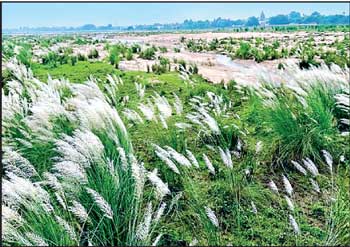Thursday Dec 18, 2025
Thursday Dec 18, 2025
Saturday, 5 October 2024 00:00 - - {{hitsCtrl.values.hits}}

In the lush greenery on the shores of the Nerañjarā River passing through Gaya, India, are the tall waving clumps of Kusā grass or Saccharum spontaneum. I found these grasses to be a common sight along the roadsides between Gaya and Nalanda in the state of Bihar.
This grass, rising up to 1.5 metres, is not just a part of the landscape but also a participant in the lives of the people. It serves multiple purposes — its tall blades are used in roofing, fodder, and even paper making, making it an integral part of rural Indian life.
In the remarkable and knowledge-rich Tipițaka, in the discourse from the Saṁyutta Nikāya (Linked Discourses 22.93), the Buddha uses the imagery of Kusā grass to convey a profound teaching.
The sutta, known as Nadīsutta or “A River,” is set in Sāvatthī and presents a vivid metaphor:
“Suppose, monks, there was a mountain river, swift, flowing far, sweeping everything along. On both banks, if wild sugarcane, kusa grass, reeds, vetiver, or trees were to grow, they would hang over it. And if a person being swept away by the current were to grasp at the wild sugarcane, kusa grass, reeds, vetiver, or trees, they would break off and that person would come to disaster and misfortune because of that. If he grabbed the wild sugarcane, kusa grass, reeds, vetiver, or trees, they would break off. Hence, he would come to disaster and misfortune.”
“Seyyathāpi, bhikkhave, nadī pabbateyyā ohārinī dūra gamā sīghasotā. Tassā ubhosu tīresu kāsā cepi jātā assu, te na ajjholambeyyu ; kusā cepi jātā assu, te na ajjholambeyyu ; pabbajā cepi jātā assu, te na ajjholambeyyu ; bīra ā cepi jātā assu, te na ajjholambeyyu ; rukkhā cepi jātā assu, te na ajjholambeyyu . Tassā puriso sotena vuyhamāno kāse cepi ga heyya, te palujjeyyu . So tatonidāna anayabyasana āpajjeyya. Kuse cepi ga heyya, pabbaje cepi ga heyya, bīra e cepi ga heyya, rukkhe cepi ga heyya, te palujjeyyu . So tatonidāna anayabyasana āpajjeyya.
In the same way, an unlearned ordinary person has not seen the noble ones, and is neither skilled nor trained in the teaching of the noble ones. They’ve not seen true persons, and are neither skilled nor trained in the teaching of the true persons.
Evameva kho, bhikkhave, assutavā puthujjano ariyāna adassāvī ariyadhammassa akovido ariyadhamme avinīto, sappurisāna adassāvī sappurisadhammassa akovido sappurisadhamme avinīto
In these passage, Kusā grass is mentioned alongside other natural elements overhanging a tumultuous river. The Buddha describes how an ordinary person, untrained in the noble teachings, is like someone being swept away by a river’s current, grasping at these overhanging plants — be it the sturdy vetiver or the delicate Kusā grass — only to find that they break away, leading to further peril.
This metaphor speaks volumes about the nature of life’s difficulties. Just as the Kusā grass, despite its uses, cannot withstand the force of a sweeping current when grasped in desperation, so too can the untrained mind find itself ill-equipped to handle the torrents of life’s challenges without the wisdom of the noble teachings.
The references to Kusā grass within the discourses of the Buddha serve to validate and enrich the teachings, grounding them in the tangible elements of the natural world that were familiar to his contemporaries and remain poignant today.
The relevance of this teaching today is profound. In a world that often feels as tumultuous as a rushing river, the Buddha’s words remind us of the importance of grounding ourselves in wisdom and training. The qualities of Kusā grass — its ubiquity, its usefulness, yet its ultimate fragility in the face of overwhelming forces—serve as a reminder that while we may find temporary support in material things, true stability can only be found through spiritual insight and moral fortitude.
As we reflect on the Buddha’s teachings, the image of Kusā grass swaying by the roadside in Gaya becomes a symbol not just of rural India’s landscape, but of the potential for wisdom to grow in fertile soil.
It is in understanding and applying these ancient lessons that we find our own strength to withstand the currents of life, not by clinging desperately to what may break and sweep us away, but by cultivating a mind that can navigate through life’s challenges with clarity and composure.
In embracing this teaching of the Tathāgata, rooted in the natural world, reaches across the ages to speak to us today, urging us toward a path of greater awareness, understanding, and peace.
(DdS)